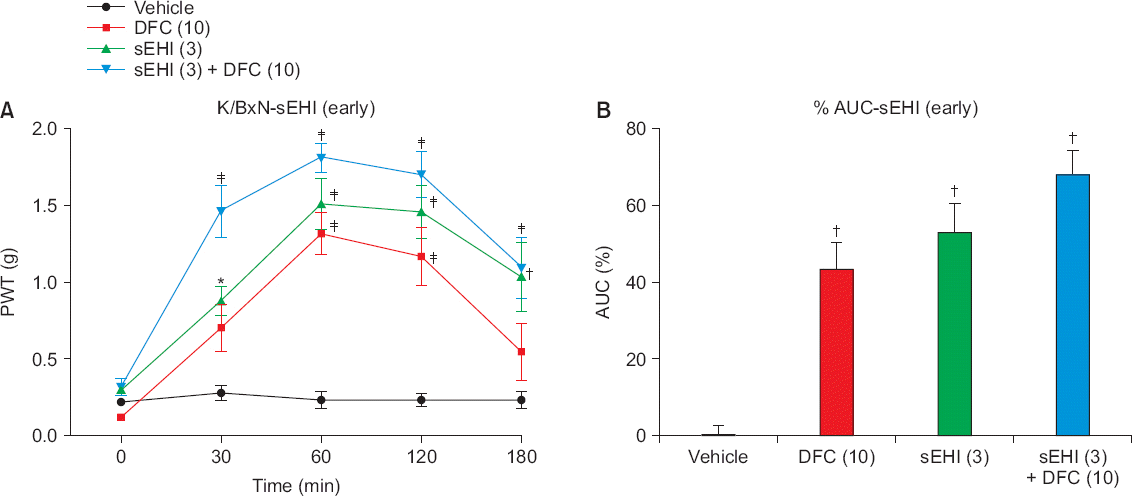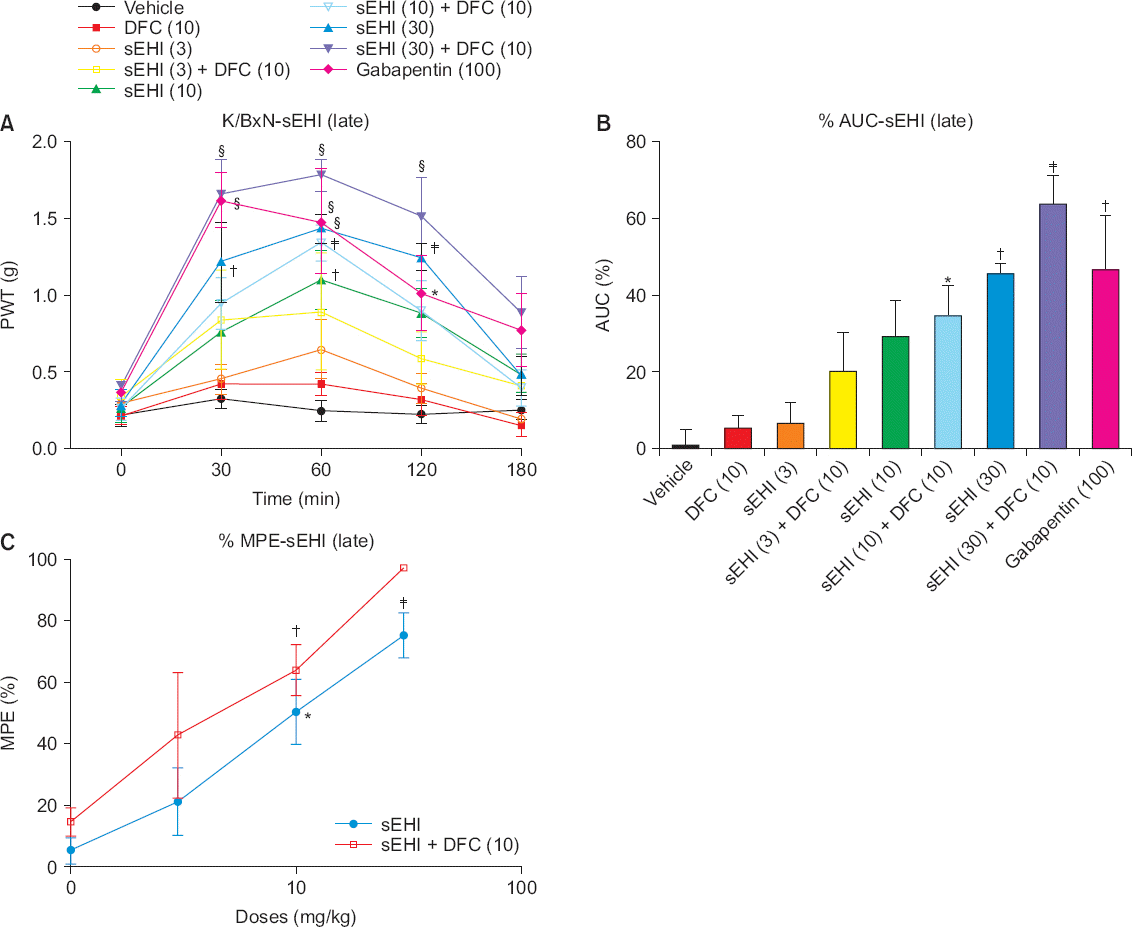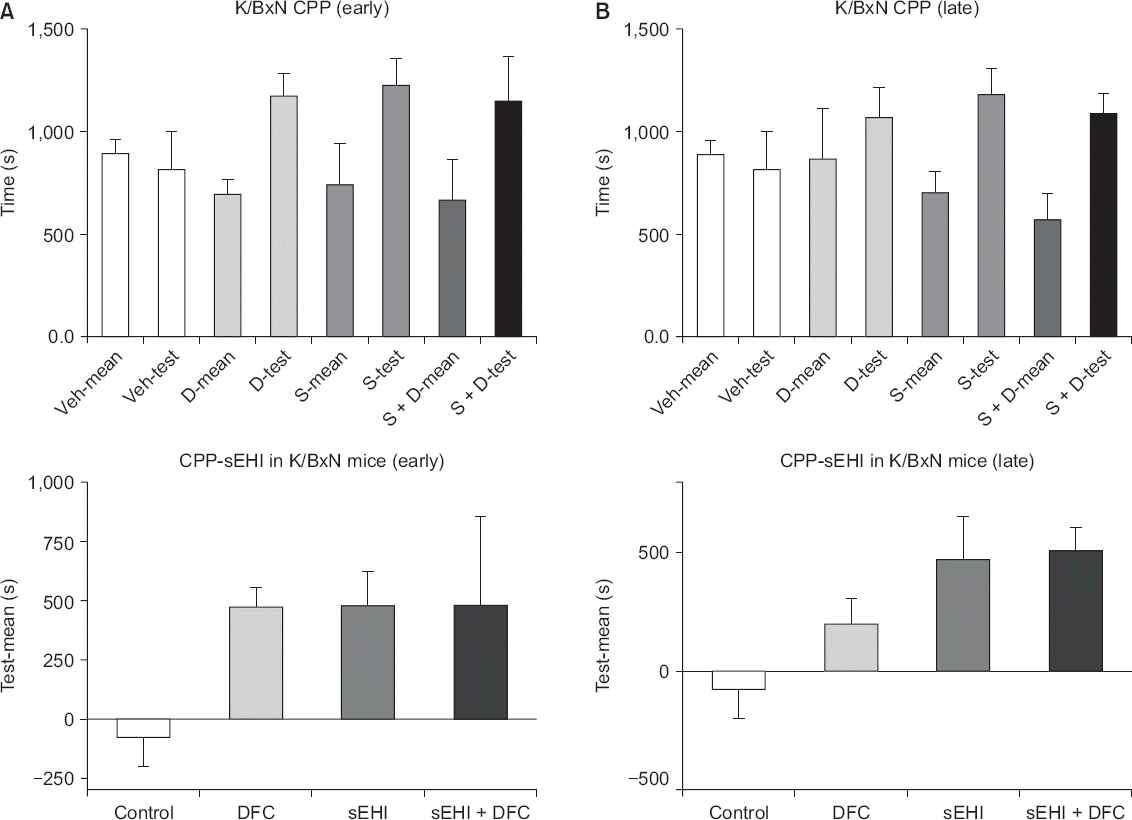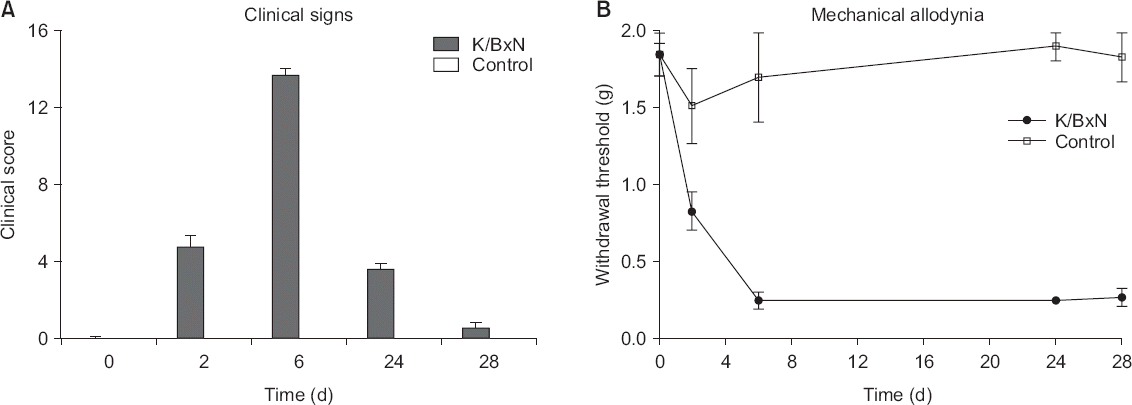1. Park HJ, Sandor K, McQueen J, Woller SA, Svensson CI, Corr M, et al. The effect of gabapentin and ketorolac on allodynia and conditioned place preference in antibody-induced inflammation. Eur J Pain. 2016; 20:917–25. DOI:
10.1002/ejp.816. PMID:
26517300. PMCID:
PMC5986296.
2. Bas DB, Su J, Sandor K, Agalave NM, Lundberg J, Codeluppi S, et al. Collagen antibody-induced arthritis evokes persistent pain with spinal glial involvement and transient prostaglandin dependency. Arthritis Rheum. 2012; 64:3886–96. DOI:
10.1002/art.37686. PMID:
22933386.
4. Inceoglu B, Bettaieb A, Trindade da Silva CA, Lee KS, Haj FG, Hammock BD. Endoplasmic reticulum stress in the peripheral nervous system is a significant driver of neuropathic pain. Proc Natl Acad Sci U S A. 2015; 112:9082–7. DOI:
10.1073/pnas.1510137112. PMID:
26150506. PMCID:
PMC4517273.
6. Bystrom J, Wray JA, Sugden MC, Holness MJ, Swales KE, Warner TD, et al. Endogenous epoxygenases are modulators of monocyte/macrophage activity. PLoS One. 2011; 6:e26591. DOI:
10.1371/journal.pone.0026591. PMID:
22028915. PMCID:
PMC3197524.
7. Campbell WB, Gebremedhin D, Pratt PF, Harder DR. Identification of epoxyeicosatrienoic acids as endothelium-derived hyperpolarizing factors. Circ Res. 1996; 78:415–23. DOI:
10.1161/01.RES.78.3.415. PMID:
8593700.
8. Chen J, Capdevila JH, Zeldin DC, Rosenberg RL. Inhibition of cardiac L-type calcium channels by epoxyeicosatrienoic acids. Mol Pharmacol. 1999; 55:288–95. PMID:
9927620.
9. Christianson CA, Corr M, Firestein GS, Mobargha A, Yaksh TL, Svensson CI. Characterization of the acute and persistent pain state present in K/BxN serum transfer arthritis. Pain. 2010; 151:394–403. DOI:
10.1016/j.pain.2010.07.030. PMID:
20739123. PMCID:
PMC2955775.
10. Crofford LJ. Use of NSAIDs in treating patients with arthritis. Arthritis Res Ther. 2013; 15(Suppl 3):S2. PMID:
24267197. PMCID:
PMC3891482.
11. Jhun HJ, Ahn K, Lee SC. Estimation of the prevalence of osteoarthritis in Korean adults based on the data from the fourth Korea national health and nutrition examination survey. Anesth Pain Med. 2010; 3:201–6.
14. Prus AJ, James JR, Rosecrans JA. Conditioned place preference. Methods of Behavior analysis in Neuroscience. 2nd ed. Buccafusco JJ, editor. Boca Raton: CRC Press;2009. p. 96–104.
15. Xu X, Li R, Chen G, Hoopes SL, Zeldin DC, Wang DW. The role of cytochrome P450 epoxygenases, soluble epoxide hydrolase, and epoxyeicosatrienoic acids in metabolic diseases. Adv Nutr. 2016; 7:1122–8. DOI:
10.3945/an.116.012245. PMID:
28140329. PMCID:
PMC5105036.
16. Park HJ, Sandor K, McQueen J, Woller SA, Svensson CI, Corr M, et al. The effect of gabapentin and ketorolac on allodynia and conditioned place preference in antibody-induced inflammation. Eur J Pain. 2016; 20:917–25. DOI:
10.1002/ejp.816. PMID:
26517300. PMCID:
PMC5986296.
17. Mease P, Hanna S, Frakes EP, Altman RD. Pain mechanisms in osteoarthritis: understanding the role of central pain and current approaches to its treatment. J Rheumatol. 2011; 38:1546–51. DOI:
10.3899/jrheum.100759. PMID:
21632678.
18. Mullin CA, Hammock BD. Chalcone oxides--potent selective inhibitors of cytosolic epoxide hydrolase. Arch Biochem Biophys. 1982; 216:423–39. DOI:
10.1016/0003-9861(82)90231-4. PMID:
7114846.
19. Okun A, Liu P, Davis P, Ren J, Remeniuk B, Brion T, et al. Afferent drive elicits ongoing pain in a model of advanced osteoarthritis. Pain. 2012; 153:924–33. DOI:
10.1016/j.pain.2012.01.022. PMID:
22387095. PMCID:
PMC3313555.
20. Harder DR, Campbell WB, Roman RJ. Role of cytochrome P-450 enzymes and metabolites of arachidonic acid in the control of vascular tone. J Vasc Res. 1995; 32:79–92. DOI:
10.1159/000159080. PMID:
7537544.
21. Kanellopoulos AH, Matsuyama A. Voltage-gated sodium channels and pain-related disorders. Clin Sci (Lond). 2016; 130:2257–65. DOI:
10.1042/CS20160041. PMID:
27815510.
22. Liu CY, Lu ZY, Li N, Yu LH, Zhao YF, Ma B. The role of large-conductance, calcium-activated potassium channels in a rat model of trigeminal neuropathic pain. Cephalalgia. 2015; 35:16–35. DOI:
10.1177/0333102414534083. PMID:
24820887.
23. Moini Zanjani T, Ameli H, Labibi F, Sedaghat K, Sabetkasaei M. The attenuation of pain behavior and serum COX-2 concentration by curcumin in a rat model of neuropathic pain. Korean J Pain. 2014; 27:246–52. DOI:
10.3344/kjp.2014.27.3.246. PMID:
25031810. PMCID:
PMC4099237.
24. Wagner KM, McReynolds CB, Schmidt WK, Hammock BD. Soluble epoxide hydrolase as a therapeutic target for pain, inflammatory and neurodegenerative diseases. Pharmacol Ther. 2017; 180:62–76. DOI:
10.1016/j.pharmthera.2017.06.006. PMID:
28642117. PMCID:
PMC5677555.
25. Iliff JJ, Wang R, Zeldin DC, Alkayed NJ. Epoxyeicosanoids as mediators of neurogenic vasodilation in cerebral vessels. Am J Physiol Heart Circ Physiol. 2009; 296:H1352–63. DOI:
10.1152/ajpheart.00950.2008. PMID:
19304946. PMCID:
PMC2685348.
26. Xu D, Li N, He Y, Timofeyev V, Lu L, Tsai HJ, et al. Prevention and reversal of cardiac hypertrophy by soluble epoxide hydrolase inhibitors. Proc Natl Acad Sci U S A. 2006; 103:18733–8. DOI:
10.1073/pnas.0609158103. PMID:
17130447. PMCID:
PMC1693731.
27. Norwood S, Liao J, Hammock BD, Yang GY. Epoxyeicosatrienoic acids and soluble epoxide hydrolase: potential therapeutic targets for inflammation and its induced carcinogenesis. Am J Transl Res. 2010; 22:447–57. PMID:
20733953. PMCID:
PMC2923867.
28. Marowsky A, Burgener J, Falck JR, Fritschy JM, Arand M. Distribution of soluble and microsomal epoxide hydrolase in the mouse brain and its contribution to cerebral epoxyeicosatrienoic acid metabolism. Neuroscience. 2009; 163:646–61. DOI:
10.1016/j.neuroscience.2009.06.033. PMID:
19540314.
29. McLellan GJ, Aktas Z, Hennes-Beean E, Kolb AW, Larsen IV, Schmitz EJ, et al. Effect of a soluble epoxide hydrolase inhibitor, UC1728, on LPS-induced uveitis in the rabbit. J Ocul Biol. 2016; 4:10.13188/2334-2838.1000024. DOI:
10.13188/2334-2838.1000024. PMID:
28066796. PMCID:
PMC5218821.







 PDF
PDF Citation
Citation Print
Print




 XML Download
XML Download